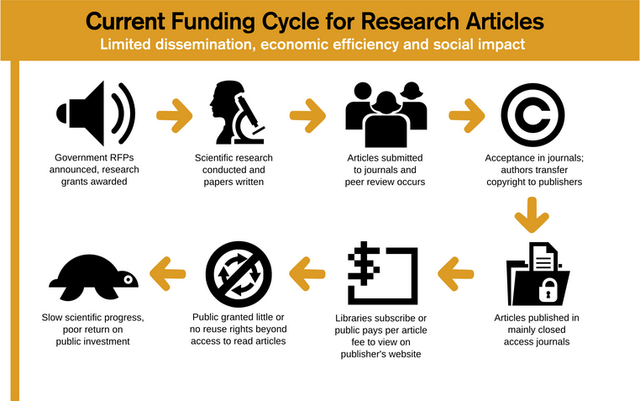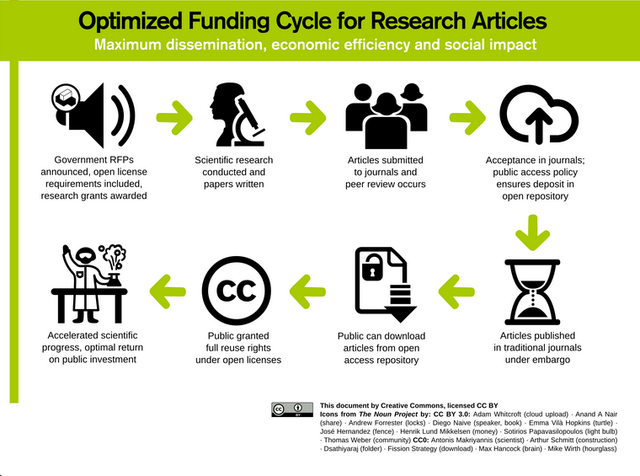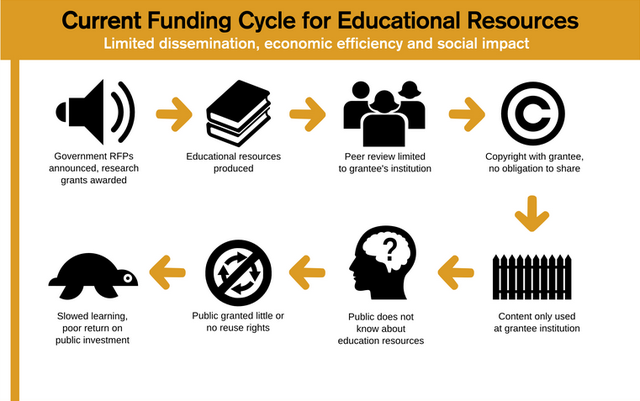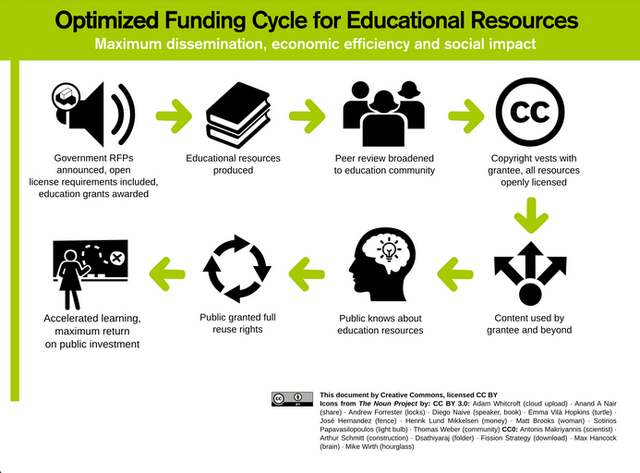This blog post was written by Teresa Sempere García, CC’s Community Support Intern June-August, 2013. The cycle graphics below were designed by Timothy Vollmer and Teresa Sempere García.
The current system for public access to research articles and educational materials is broken: ownership is often unclear, and the reuse of knowledge is limited by policies that do not maximize the impact of public funding. The following graphics will try to simplify and compare two alternative funding cycles for research publications and educational resources that emphasize the positive impacts of open policies on publicly-funded grants. More information and links to a current directory of current and proposed OER open policies can be found in the OER Policy Registry on the Creative Commons Wiki.
Cycles for Research Articles
The existing system for producing and distributing publicly funded research articles is expensive and doesn’t take advantage of the possibilities of innovations like open licensing. Without a free-flowing system, access to the results of scientific research is limited to institutions that are able to commit to hefty journal subscriptions — paid for year after year — which don’t allow for broad redistribution, or repurposing for activities such as text and data mining without additional permissions from the rightsholder. This closed system limits the impact on the scientific and scholarly community and progress is slowed significantly.
A Closed Research Model

When funding cycles for research include open license requirements for publications, increased access and opportunities for reuse extends the value of research funding. As an example, the US National Institutes of Health (NIH) Public Access Policy requires the published results of all NIH-funded research to be deposited in PubMed Central’s repository, the peer-reviewed manuscript immediately, and the final journal article within twelve months of publication. Similarly, the recent directive issued by the White House Office of Science and Technology Policy mandates that federal agencies with more than $100 million in research expenditures must make the results of their research publicly available within one year of publication, and better manage the resultant data supporting their results. These policies utilize aspects of the optimized cycle below, and are a step in the right direction for making better use of public funding for research articles.
An Open Research Model

Cycles for Educational Resources
The incumbent system for developing and sharing publicly funded educational resources doesn’t guarantee materials are accessible and reusable by the public that paid for their creation.
A Closed Education Model

If policies are put in place that mandate open licenses on publicly funded educational resources, knowledge can flow more freely because the public is clear about how they may reuse educational content, and the funders can realize a more impactful return on their investments. An example of better use of public funding for the production of educational resources, the US DOL TAACCCT Program mandates that all content created or modified using grant funds are openly-licensed (CC BY) and deposited in a public repository upon completion of the project. Being conducted in four waves, the TAACCCT program is making better use of a large (US$2 billion) investment of US taxpayer money by ensuring the public will have access the educational resources created during the four-year term, and is able to reuse and adapt them beyond what automatic copyright allows. The following graphic demonstrates an open funding model, with licensing and access recommendations to remove barriers to sharing and help speed access and reuse of publicly funded educational content.
An Open Education Model

Summary
Open policy — specifically, the idea that publicly funded materials should be openly licensed materials — is a sensible solution that ensures the public’s right to reuse the materials it paid for, and improves the efficiency of government grant funding. Open licensing is a sensible requirement for publicly funded grant programs.







Something to think about here: some grantees who are given partial funding to start a project usually are given that money with the knowledge that the grantee will develop a project that the grantee will then sell or license (perhaps at lower cost since the grantee’s costs are partially mitigated by the partial grant) the material in order to make up what they don’t get in funding. How would your model make sure that grantees are paid fully for their work and not face having to give partially funded work to the public domain? There are many grants that are like this: they’re called “seed” grants and they are given with the explicit knowledge that the seed helps the product grow and that those who do the work are paid fully for their efforts out of the proceeds. Your plan would deter many people from working on such projects and many good works would never get done.
I perform multidisciplinary research in all the sciences. The results were: I discovered the genetic code, digital table periodic table of elements, matrix of insulin, codes that connect the heavenly bodies, codes in theoretical physics and chemistry, etc. He published’m less than 1% of those of my discoveries. The remaining 99% of the discovery can not publish, because I have no money for these costs. Existing systems of financing science does not support independent researchers. I think that humanity will have tremendous damage because it allows poor authors to publish their scientific papers.
I’m a fan. You could, however, make the point more obvious by including a step before “government funding”: “the public pays tax in order to live in a better society/world”. It is precisely this tacit agreement between government and public that current practice seem not to honor.
I am not sure I agree with the “Optimized Funding Cycle for Research Articles” Graphic- Correct me if I am wrong, but posting on a public repository does not necessarily mean that the user has rights beyond downloading and “viewing”. If what is deposited is the peer reviewed (accepted) version of the article or the final formatted article, then those versions are going to be subject to whatever terms are in the copyright transfer agreement or licence to publish. So while users might be able to download and “use” the material, they are only able do “reuse” under fair use/fair dealing restrictions. A public repository does not require that there be a CC licence. When there is a cc licence (with the exception of a few journals that require a limited time limit licence to publish) then there is no embargo – and the manuscript can be deposited immediately in a repository. am I missing something?
@DT: The improved cycle emphasizes the application of open copyright licenses on journal articles, the same information that would already be available to a small section of the public that has the financial resources to invest in journal subscriptions. Open licensing of these articles would not necessarily affect rights associated with other outputs of the project. Researchers accepting grant funding from multiple sources (including public agencies) should be aware of OA mandates such as the NIH policy, which affects research projects funded partially (or in whole) with public monies. OA policies for grants made with public funds are meant to extend the benefits of research to as many people as possible, and may not be ideal for research projects that rely on direct financial proceeds (from the funded project) that have yet to be realized.
@Fabiana: The open licensing of materials and have access those materials are two separate aspects, with open licensing not necessarily conflicting with an embargo period. A more optimized cycle might be, as you said, to include the application of an open license at the time of original deposit in an open repository, though it’s good to note that an open license can be applied at any time (immediately, after the embargo period, or a later date), depending on variations in grant requirements. Hope that clears things up.
The problem is, how to transition to a model with an open education and open research activities, when there are so many (hidden) huge budgets with interests in these areas?
In many developed countries (those that can afford education and research), politics get funded one way or another by companies that either print books or get patents from research made at public universities, just to mention a couple common cases…